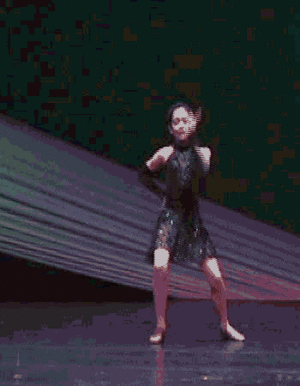Handspring (gymnastics) facts for kids

A handspring is an exciting acrobatic move where a person flips their body completely around. Imagine starting upright, then lunging headfirst into an upside-down position. From there, you push off the floor with your hands to spring back up to your feet! It's like a powerful, controlled flip.
You can do a handspring moving forward or backward. You can also start from a standing position or while running. Handsprings are a big part of many physical activities. You'll often see them in acro dance, cheerleading, and gymnastics. In competitions, judges look at how well these moves are performed.
Contents
What is a Handspring?
A handspring is all about rotating your body. You use your hands to push off the ground. This helps you complete a full rotation.
Types of Handsprings
There are two main types of handsprings:
- A front handspring means you rotate forward. You can see where your hands will land.
- A back handspring means you rotate backward. This one is trickier because you don't see your hands land until the move has already started!
When a handspring begins from a standing still position, it's called a standing handspring. For example, a standing back handspring starts when you are not moving.
Handsprings can also be linked together. You might do a roundoff first to get speed. Then, you can perform a handspring. After a handspring, you might immediately go into another flip or somersault. This creates a cool sequence of moves!
Handsprings in Gymnastics
Handsprings are super important in artistic gymnastics. Gymnasts perform them in the floor exercise, on the vault, and even on the balance beam.
On the floor, gymnasts often do a roundoff right before a back handspring. This combination gives them lots of speed and power. This power helps them perform amazing backward somersaults afterward.
How to Do a Back Handspring
Let's break down how a standing back handspring works. It happens in a few quick steps:
- Step 1: Get Ready! You start standing tall with your feet flat.
- Step 2: Swing and Sit! You swing your arms down by your sides. Then, you bend your knees and sit back. Imagine you're sitting in an invisible chair.
- Step 3: Jump and Arch! You quickly swing both arms up by your ears. You use your back muscles to push your upper body. Then, you jump into the air! Your body forms an arch shape. Your head stays neutral, and your arms and legs are straight and together.
- Step 4: Hands Down, Push Off! You keep that arch shape until your hands touch the floor. As your hands connect, you use your body's momentum. You change your body shape from an arch to a straight line, then to a slightly curved "hollow" shape. Then, you push hard against the floor with your hands. This push lifts your body off the ground.
- Step 5: Land It! Your body continues to rotate feet-first. Your feet land on the floor behind your body's center. You use the rest of your momentum to stand up straight and still.
Performing handsprings on the balance beam is a bit different. Gymnasts use more up-and-down force. This helps them place their hands carefully on the narrow beam.
Cool Handspring Variations
There are many ways to perform a handspring, each with its own flair!
- Front Handsprings: While you can start a front handspring from standing, gymnasts often run and hurdle into them. This gives them more speed. Some front handsprings can also include a "step out." This means landing one foot at a time, which is useful on the beam.
- Back Handspring Step-Out: This is a popular variation on the balance beam. The gymnast splits their legs when they take off. They reach a full split when upside down. Then, they land one foot at a time. This move is great for starting other combinations. It also puts less stress on the arms.
- Twisting Handsprings: Some handsprings include twists!
- The Worley is a back handspring. But, it adds a half twist in the air. This makes it turn into a front handspring!
- The Onodi is another skill. It's a back handspring with a half twist. After the twist, the gymnast goes into a front walkover.
- Handsprings for Vaults: Handsprings are key for generating power in the vault event. The simplest vault involves a front handspring. The gymnast pushes off the vault surface. Vaults are grouped by whether the handspring is forward or backward. They also depend on if there's a twist in the air. For example, the Tsukahara vaults use a twisting front handspring. The Yurchenko vaults use a back handspring.
- Flyspring: In this front handspring variation, the gymnast keeps their feet together from start to finish. This means they have to jump into the move with both feet at once.
See also


